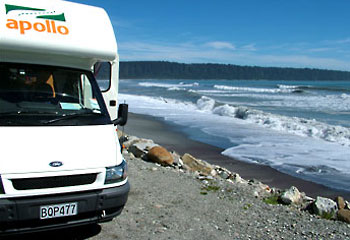Hit the road in a mini-home
NEW Zealand's landscape is majestic. To be appreciated fully, see it as you taste a good wine: slowly making travel by motorhome a good way to go.

THE first mistake we made was to allow only two weeks to cover New Zealand by motorhome. The second was to believe the published driving times between places.
Experience now tells us to add another 25 per cent – especially on the South Island, where roads are narrower and bendier than in the north.
New Zealand's landscape is majestic. It ranges from towering, snow-capped mountains to rich green pastures cut by swift-flowing rivers.
To be appreciated fully, it has to be seen like you taste a good wine: slowly, allowing the richness of the landscape to linger on the senses.
And travel by motorhome is a good way to go. You can make your own pace without having to worry about finding a night's accommodation. You can even stop beside a road, often as not with a lake or mountain view. You're self-contained, with power, gas and water.
Costing from $NZ70 (about $57) a day for a four-berth motorhome and adding about $NZ25 ($20) a night for a powered site at a caravan park, a motorhome also becomes an attractive alternative to renting a car and paying motel bills.
Our 2700km trip took us from Christchurch south along the coast to Oamaru and Dunedin, then to Milton and across country to Queenstown before heading north to Wanaka, through the Haast Pass to the mountain country of Fox Glacier and Franz Josef Glacier.
From there, we drove north through Greymouth to Nelson and Picton, where we crossed Cook Strait by inter-island ferry to Wellington.
From Wellington, we headed north-east to Hastings and Napier, then inland again to Taupo, Rotorua and Hamilton, ending our trip in Auckland.
Had we more time, we would have gone to the popular South Island destinations of Milford Sound and Mt Cook.
This was our first experience of a motorhome. Just why motorhomes are popular we were to find out as we hit the road. It didn't take us long to begin enjoying the lifestyle, the freedom and the flexibility.
Like the tortoise, we were taking our home with us. And it wasn't long before we were exchanging cheery waves with others on the road.
What is also so special with a motorhome is that you unpack only once for the whole trip.
And you have all the facilities to prepare meals – even out on the road – thus saving on expensive restaurant meals.
We picked up our four-berth home from the Apollo team in Christchurch. It was surprising how much can be built into this home on wheels: two double bunks, a well-appointed kitchenette and a bathroom with shower and toilet. Plenty of cupboard space, too. But take a collapsible bag, instead of a suitcase, for ease of stowing.
Although there were only two of us, we were glad of the extra room a four-berth motorhome gave us. My 190cm frame was comfortably accommodated under the roof and on a bed.
With unleaded petrol at $1.55 a litre and diesel selling at just $1.16, it's important to make sure you get a diesel vehicle.
Our half-hour briefing introduced us to the home's features: gas stove, heater, air conditioner, microwave, hot water, and, yes, television.
Make sure you are shown how everything works – not just have them tell you.
Take note of the waste-water system. We didn't use the motorhome's bathroom, preferring, like most, to use the facilities at caravan parks.
Apollo provided a us with starter kit – soap, tea, coffee etc – but we stopped at the first supermarket to stock up.
It took us a day or two to find the rhythm of motorhome living and driving.
The driver had to adjust to the length and breadth of the vehicle, and it took us time to work out how to pack it efficiently and safely.
Caravan parks are plentiful in New Zealand. We found the Top Ten chain to have a generally high standard – judged by their bathrooms and toilets.
Most parks also have a laundry and kitchen as well as a community lounge room with television, books and games.
Some parks have playgrounds for children – a good idea after a day on the road. Except in the peak summer season, it's generally not necessary to book caravan parks ahead.
The Rainforest Caravan Park at Franz Josef was special. It caters for all levels of accommodation, from premium (tree lodges) to backpacker, motel units and caravan sites. It has an excellent bar and restaurant on site.
One disadvantage of a motorhome, we found, is that if you want to go anywhere after you've checked into a caravan park, you have to take the motorhome with you. We solved that by getting taxis the short distance into town or to nearby sightseeing destinations.
The writer travelled courtesy of Apollo Motorhome Holidays and Tourism New Zealand.
The Sunday Telegraph

